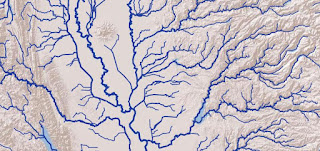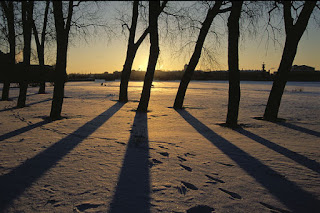A river system revealed as a drawing
Nelson Minar created software whereby when used we could see how river networks operated across vast territories, therefore we could reset our thinking in relation to familiar maps of the world. His coding was still available when I was writing this post; see and it came with a warning that as coding it was already becoming out of date. What I thought was important about these drawings was the symbiotic link between various human and natural phenomena. The land itself is shaping its own traces; as rain falls water flow responds to the terrain it finds and as it does so it finds its way down towards sea level. This finding a way cuts through a vast range of geological differences, but eventually the dendritic shapes of rivers and streams and rivulets and river basins become clear and tell their own story. The thinking of someone like Minar will begin with an awareness of his own body. The fact that our human bodies include similar dendritic systems; arteries, veins and nervous systems that are often in illustrations similarly colour coded, is I'm sure an important element here. The coding done by Minar is also something that is 'rooted' in a topographical awareness of surfaces and boundaries. Mathematics, coding, human biology, embodied thinking, geology, weather systems, physics and chemistry all becoming enmeshed in drawing.
Publicly available data is also an important element, free information being essential to a non-capitalist economy of thinking. Thinking without resorting to thinking about how individual gains can be made is becoming more and more important to my own idea of why I am engaged in this project of thinking through drawing. Find the open source information for North American river systems here.
The rivers of the American Southern States visualised using Nelson Minar's code.
A snail trail is something we have all seen. Snails produce a type of mucus, 'snail slime', that is used to help them crawl along. It is partly like a glue and partly like a lubricant, thus helping a snail to climb up surfaces as well as along floors. This silvery track is a sign used by humans to check whether or not their environment is sealed off from the outside world or not and by other animals as a sign that food is present.
Snail trail
Years ago I read a short story about a mathematician, a Buddhist monk and a Christian priest in conversation. The monk believed in reincarnation and the idea of karma, the priest also had an insight into these issues and often quoted from the bible to explain his truths to the other two. In this case he quoted Galatians 6:7; "Whatsoever a man soweth, that shall he also reap”. Neither was able to convince the other of the 'rightness' of their religion and the mathematician was also not convinced by either of the religious scholars and stated that "where there is life there is a pattern, and where there is a pattern there is mathematics", a famous quote taken from the mathematical scholar John Barrow. There was no conclusion to their conversation which was years later being reflected upon by the Christian priest, who was sitting on a bench reminiscing on the fact that the other two people in the conversation were now dead. As the priest related this remembered incident he began watching a snail moving across the floor just on front of his feet and leaving a trail of slime. The snail seemed to be moving in a purposeful manner and the priest decided to keep a close eye on what it was doing. Gradually the snail traced out the mathematical symbol pi. Well I think that was the story, I read it a long time ago, and it stayed with me.
Pi snail trail
This drawing in a story weaves together several things, mathematics, religion, nature, belief and the fact that a drawing done by a non human actant is central to the narrative.
Coyote Buttes slopes: Arizona and Utah border
Differential erosion creates beautiful landscapes, which reveal variabilities in rock hardness as wind and water act together to shape the face of the planet. New drawings are made as lines of difference emerge, rocks laid down in seas millions of years ago now exposed as contour bands drawn across the undulating earth. This is little different to artists cutting into surfaces to reveal different colours and textures, Penny Evans' ceramics being typical examples of sgraffito, the scraping and digging away of surfaces in order to find new colours and forms beneath.
Penny Evans: Sgraffito used on ceramics
We use the same processes when drawing as nature does. This is not really a process of mimicry, I would suggest it is simply how things go. We are all physical things and part of nature, so perhaps it is no surprise that wind and rock operate in a very similar way to people and clay.
I have looked at shadows as a way of thinking about drawing in earlier posts, but what if we look at the world itself as a drawer of shadow shapes? As the Earth revolves around the sun and spins on its axis, a constantly changing series of shadow landscapes are made.
Everything that projects above the ground has the potential to project a shadow on cloudless days, and these projections are in constant movement, a movement that informs us about the changing relative positions of Earth and Sun. We have of course used this fact to develop our idea of time and sundials are just one of the many ways that human beings have harnessed shadows. In plants certain proteins can detect changes in light, so when the plant experiences a time of being in shadow, it holds back the photosynthesis process so that the plant doesn't waste energy trying to make use of the sun's energy when it is not available. This protein is so sophisticated that it allows the plant to make decisions about very subtle differences, such as whether there is a passing shadow, such as a cloud obscuring the sun, a chance flicker of light or the light fading because it is the end of the day. It could be argued that plants understand and use shadow much better than we do.
I have looked at shadows as a way of thinking about drawing in earlier posts, but what if we look at the world itself as a drawer of shadow shapes? As the Earth revolves around the sun and spins on its axis, a constantly changing series of shadow landscapes are made.
A very basic sundial
*Plato asks us to imagine prisoners chained in a cave, they are unable to turn their heads, and all they can see is therefore the cave wall. Behind them is a fire and between it and the prisoners is a low wall along which move puppeteers that manipulate puppets and objects in order to develop particular stories about the world. The prisoners are totally unaware of the puppeteers and what is going on behind them, all they can see are the shadows cast on the wall in front of them. This situation is he explains what we actually experience in comparison to pure reality or the ideal forms that underpin all experience. So when we look at the shadow of the woman holding a child, if we could not see the woman, but only the shadow we would think she was pregnant, a type of mistaken deduction that Plato suggests we constantly make.
See also:
Drawing as entanglements of life
Drawing as the trace of a touch
Patternings, ties, entanglements and knots
Drawing as a model for life experience
Drawing to an end










This comment has been removed by a blog administrator.
ReplyDeleteThis comment has been removed by a blog administrator.
ReplyDelete